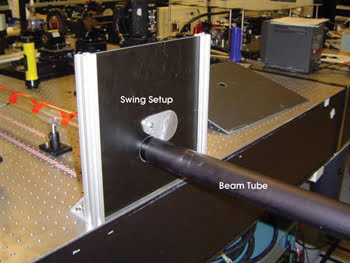Getting a laser beam from one point to another can be anything but straightforward.
Ken Barat, Lawrence Berkeley National Laboratory
There are times when a laser beam must cross between tables or must even travel from one room to another. This presents an interesting traffic flow and safety challenge to both the laser safety officer and the laser user. Fortunately, there are several solutions, although the simplest may not be the best. For example, the simplest way to direct a beam from one optical table to another is to put a sturdy tube around it. That is a permanent solution, and it completely contains the laser beam. However, although this method is laser safe, it can be an egress hazard if it blocks a walkway, especially if the room is dark. One comment this author often hears is, “We can just duck under the tube.” The fire marshal as well as the laser safety officer might object to this setup.

If the beam tube is not in place, the small metal shutter swings down to block the beam (which is traveling left to right in this photo).
One good solution is to transport the beam from point A to point B through a fiber optic cable, when that is possible. One should be able to run the fiber easily up and over any walkway or down through a conduit on the floor. An important concern often overlooked with fibers is a label at the termination end indicating that disconnection may expose one to laser radiation.
Suppose there is an experiment that usually is confined to a single optical table but that sometimes needs to expand to a second table. It is inconvenient to install a permanent tube between the tables, so a temporary arrangement is deemed more desirable. I often have seen people casually lay a beam tube across support arms and remove it when it is not needed. The problem with this approach is that there is no mechanism to prevent the beam from crossing if someone has forgotten the tube or if the tube gets knocked out of place.
A better solution is a mechanism that allows the beam to cross only when the beam protection is in place. A swing shutter, or a guillotine and swing arm, are examples (see figure). Another alternative is a sensor such as a microswitch that activates a shutter to block the beam path if the beam tube is removed.
Of course, some low-power beams do not really need containment at all because there is no possibility of physical harm should someone interrupt the beam. Even in these cases, however, the beam interruption is likely to disrupt the experiment, so I always suggest some sort of simple awareness device such as a sign, a swing gate or a chain across the path.
What about the case of a beam traveling from one room into the next? Here the hazard is that people in the second room are surprised when the people in the first room turn on the laser. To prevent that, the wise move is to let staff in the second room control beam entry. One approach is a shutter that can be opened only from the second room. A worthwhile safety addition is an illuminated light or LED to indicate shutter status.
In conclusion, when beams need to cross walkways and/or to enter distant rooms, awareness and beam control are necessary, and solutions do exist.
Meet the author
Ken Barat is the laser safety officer at Lawrence Berkeley National Laboratory in Berkeley, Calif.; e-mail: [email protected].